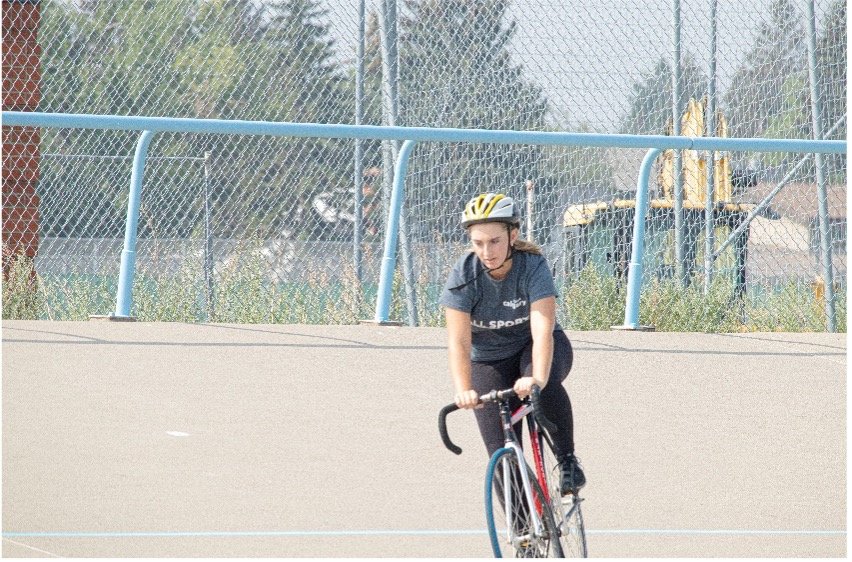The Active Interns - Summer 2023: Track Cycle
Brief History of Track Cycle:
Track Cycling has been around for over 150 years, one of the oldest and most prestigious forms of cycling. Track cycling has two main track categories, which are sprint and endurance. Track Cycle has grown in popularity since the mid-1800s and has 500 velodrome tracks in over seventy countries. As early as 1870, track races regularly attracted large crowds in England, where they competed on wooden tracks like modern velodromes. This form of cycling was introduced in the first modern Olympics, which included a men’s sprint event, but in the Seoul 1988 Olympics, the first women’s track cycling event was a sprint event. From the first modern Olympics to the Seoul 1988 Olympics, the types of track cycle events for both men and women have evolved and changed, and new events have been introduced. The Olympic track cycle events for both men and women are team sprint, sprint, keirin, team pursuit, omnium, and madison.
Track cycle is split into two main categories: sprint and endurance. Sprint includes sprint, team sprint, keirin and track time trial. Endurance includes individual pursuit, scratch race, points race, madison, and omnium. There are different types of track cycle bikes based on the kind of event you race in: sprint, endurance, and time trial.
Check out this video to learn more about track cycle!
(147) The Rules of Track Cycling - EXPLAINED! - YouTube
What is a Velodrome?
A velodrome track is an oval track that is 250 meters long, and the cycle track consists of two straight elements and two curved elements. The straight elements are 12 degrees, and the banks are 45 degrees, which pushes the rider toward the centre of the track to help the rider go faster. The track has black, red, and two blue lines.
The black line, called the measuring line, defines the length of the track; red is the sprinter's line between the black and blue lines, which is the optimum racing line; lastly, there is thin blue, called the strayer’s line that riders stay above to rest or warm up until they come back into the race. The thick blue line called the apron is the most inside the track, and no riders are allowed to race there but only to get onto and off the track.
Photo retrieved from Bicycling.co.za, Roseau Torres-Davis
Experience:
I was nervous to try the velodrome track that morning, and when I arrived to see the velodrome track, the corners were more sloped than I saw in the photos. Once you arrive, the staff welcomes and sets you up with a bike your size and adjusts the seat to your liking. After I mentioned to the staff about my nervousness, they reassured me that they would go through all the safety training, get me used to the track and understand the workings of the bike. After going through the safety training and understanding the different parts of the track and the bike, I felt less nervous about trying out the sport.
The staff helped me and showed me how to get onto the bike, and for me, it was a bit of a struggle. Since I am a short female, getting on a bicycle was hard initially, but I got the hang of it afterwards. Learned to trust myself to push myself on the bike with my dominant foot. The staff was always there to help set up the bike for you each time you wanted to go back onto the track and set up pedals to make getting your feet inserted into the pedal inserts easier. The staff also teaches you how to stop since track bikes do not contain brakes, but to do that, you need to slow your pedalling down to a rolling speed, and you can either stop the bike on the track or roll into the grass.
Once you start riding the bike on the velodrome track, you begin a few warm-up laps on the most inner part of the track called the apron. Then, you move up the first few corners, which can feel intimidating. The staff keeps encouraging you and reminding you to keep up a constant speed on the track to stay above the black line. After a couple of laps on the shortest part of the track, you get the hang of the bike and the speed you need when going into the corners, and the fear disappears. The staff allows you to take breaks and adjust to riding on the bike and track. I had to take multiple breaks due to not being on a bike for over ten years. After my first break, I returned to the track and rode above the blue line, which is generally for warm-ups and cool-downs for track cyclists. I learned you must continue that constant speed above the blue line, like riding along the black line. The staff also set up a cone drill to allow me to experience the feeling of going up and down the track on the straights, learning to slow down my pedalling and quickly turn around the cones.
At the end of the track session, I got to do a few laps with the track manager, Robert Armstrong. We both would lead a lap and break off behind one another to get that feeling of a team aspect. During the safety training, you are told to quickly check behind you to ensure nobody is around you if you want to pass or fall behind someone else to ensure it is safe to move. To pass someone, you say “stick,” which means the person would break off to the top portion of the track to allow you to go through them. Overall, the experience was great, learning how to get on and off the bike and navigate and control yourself on different parts of the track.
Equipment and Wear:
The Calgary Bicycle Track League website states that you must bring a helmet and a waiver or sign one when you arrive at the velodrome track. Appropriate wear is essential when partaking in track cycling. Wear tight-fitting clothing so nothing will catch on the bike or impact you on the track. Good closed-toed shoes such as sneakers are important to wear to feel comfortable on the bike.
How can Track Cyle be beneficial for your health:
The benefits of cycling are improved heart and lung health, stronger muscles, improved coordination and general mobility, and improved mental health. Cycling helps you improve your fitness levels by regularly working on aerobic exercises, helping people stay active and healthier for longer.
Time Commitment:
Track cycling is a physically demanding sport where the time commitment is spent in the gym and on the track. Track cyclists work in the gym on core, stability, and endurance. Track cyclists also train on the track, learning to use their bodies to become more aerodynamic and work on longer and shorter interval sprints. The time commitment an individual would need to commit to this sport would be putting 70% of their time on the track and 30% in the gym.
Risks:
One of the main risks you can encounter while being on the velodrome is watching and listening to people around you. If you are careful, you could avoid interfering with someone on their lap or moving up and down the track at an incorrect time. Which could cause an injury to yourself or damage your bike. If you want to pass someone, you need to speak loudly so others can hear you, indicating there is someone behind them and to move out of the way.
How to get involved with Track Cycle:
To get started with track cycling, attend a free session where you can learn and understand the workings of the bike and track. Going with friends or by yourself, you can learn how to ride the track and learn a new sports version of cycling. This sport would be great for endurance athletes to try something new and maintain endurance for the months they cannot compete in their primary sport. Any cyclists who have been involved or want to try track cycling can easily do it since the motions are the same, but learning the velodrome track and style of bike might be slightly different from mountain biking or road biking.
Calgary Bicycle Track League Programs:
Calgary Bicycle Track League has four programs catering to youth, adults, and women and try the track sessions.
· Youth sessions are for 9-18-year-olds, geared towards first-time, newer track and elite riders, focusing on fun and event preparation.
· Adult coach sessions help improve adults' bike handling skills for road and mountain biking, from new to elite cyclists.
· The women’s program aims to introduce riders of all ages and abilities who identify as female to come and have fun and try the sport.
· Try the track, an open session for all people to come out to the velodrome, and it’s the first step to being introduced to the sport.
I want to thank the Calgary Bicycle Track League staff for letting me come out and try track cycle. All the staff was welcoming and constantly gave me good points on improving my ride. I encourage anyone who wants or has been interested in the sport to go to Glenmore Athletic Park to try out the velodrome. Please visit the Calgary Bicycle Track League website Calgary Bicycle Track League (cbtl.ca) to learn more about their programs and organization.




